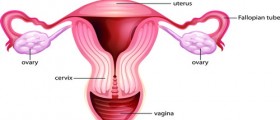
Tubal pregnancy An ectopic pregnancy is a pregnancy that develops outside of the uterus. Ectopic pregnancies most frequently develop within one of the fallopian tubes, in which case they are also called a tubal pregnancy. Tubal pregnancies cannot be carried to term, and quickly develop into a medical emergency that is life threatening for the mother, when not removed. When a tubal pregnancy is caught early on, it is sometimes possible to remove the embryo while leaving the affected fallopian tube intact. In later stages, a salpingectomy is the only treatment.
Endometriosis Endometriosis is a condition where the endometrium, the tissue that normally lines the uterus to facilitate an embyo's implantation there, also grows in other areas of the reproductive system including the fallopian tubes. Endometriosis can cause a lot of pain, but also damage. In extreme cases, the removal of the fallopian tubes may be suggested.
Hydrosalpinx Earlier in this post, you may have understood that salping means fallopian tube. Hydro is, of course, water. Hydrosalpinx is fluid in the fallopian tubes, either in one or on both sides. This can be caused by various types of infections. Other types of damage, scarring, and cysts may also lead to blocked fallopian tubes and, eventually, their removal, but in all these cases other treatment, like surgical unblocking of the tubes, will be attempted first.
Fallopian tube cancer Tubal cancer may be treated, in part, by the removal of the fallopian tube. As with breast cancer, a gene for fallopian tube cancer has now been found, and a double salpingectomy is one option that some women who carry the gene choose as a means to prevent tubal cancer.
- www.nhs.uk/conditions/ectopic-pregnancy/treatment/
- www.betterhealth.vic.gov.au/health/conditionsandtreatments/hysterectomy
- Photo courtesy of PublicDomainPictures / 18043 via Pixabay : pixabay.com/en/pregnant-women-lady-girl-boy-214522/
















Your thoughts on this
Loading...